YAMAHA FJR1300AS 2013 Owners Manual
Manufacturer: YAMAHA, Model Year: 2013, Model line: FJR1300AS, Model: YAMAHA FJR1300AS 2013Pages: 122, PDF Size: 3.34 MB
Page 91 of 122
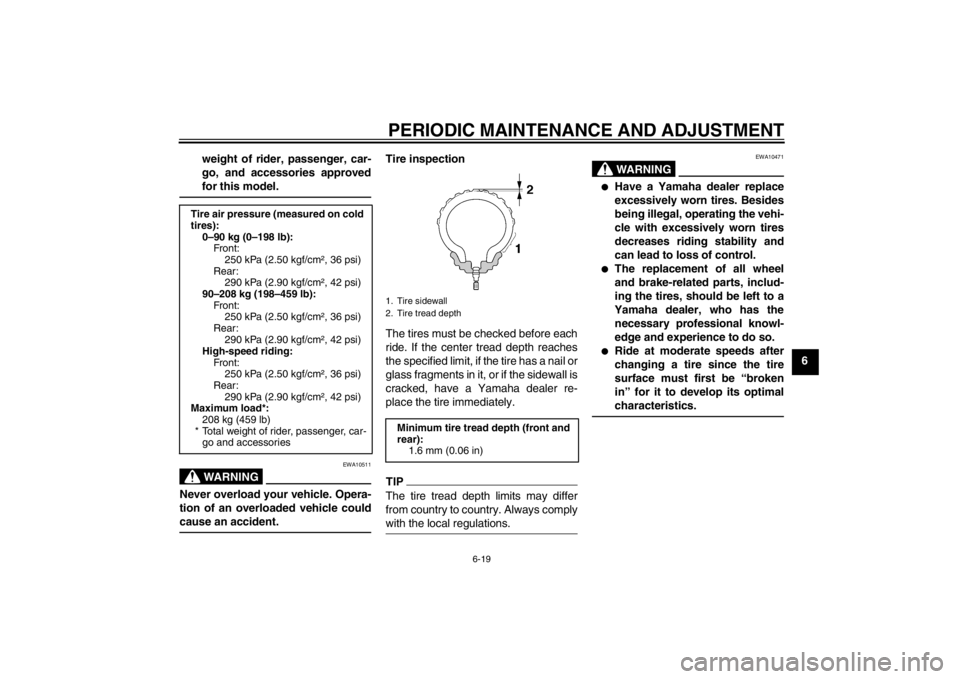
PERIODIC MAINTENANCE AND ADJUSTMENT
6-19
6
weight of rider, passenger, car-
go, and accessories approved
for this model.
WARNING
EWA10511
Never overload your vehicle. Opera-
tion of an overloaded vehicle could
cause an accident.
Tire inspection
The tires must be checked before each
ride. If the center tread depth reaches
the specified limit, if the tire has a nail or
glass fragments in it, or if the sidewall is
cracked, have a Yamaha dealer re-
place the tire immediately.TIPThe tire tread depth limits may differ
from country to country. Always comply
with the local regulations.
WARNING
EWA10471
●
Have a Yamaha dealer replace
excessively worn tires. Besides
being illegal, operating the vehi-
cle with excessively worn tires
decreases riding stability and
can lead to loss of control.
●
The replacement of all wheel
and brake-related parts, includ-
ing the tires, should be left to a
Yamaha dealer, who has the necessary professional knowl-
edge and experience to do so.
●
Ride at moderate speeds after
changing a tire since the tire
surface must first be “broken
in” for it to develop its optimal
characteristics.
Tire air pressure (measured on cold
tires): 0–90 kg (0–198 lb):Front:
250 kPa (2.50 kgf/cm², 36 psi)
Rear: 290 kPa (2.90 kgf/cm², 42 psi)
90–208 kg (198–459 lb): Front: 250 kPa (2.50 kgf/cm², 36 psi)
Rear: 290 kPa (2.90 kgf/cm², 42 psi)
High-speed riding:
Front: 250 kPa (2.50 kgf/cm², 36 psi)
Rear:
290 kPa (2.90 kgf/cm², 42 psi)
Maximum load*: 208 kg (459 lb)
* Total weight of rider, passenger, car- go and accessories
1. Tire sidewall
2. Tire tread depth
Minimum tire tread depth (front and
rear): 1.6 mm (0.06 in)
U1MDE0E0.book Page 19 Friday, February 15, 2013 1:26 PM
Page 92 of 122
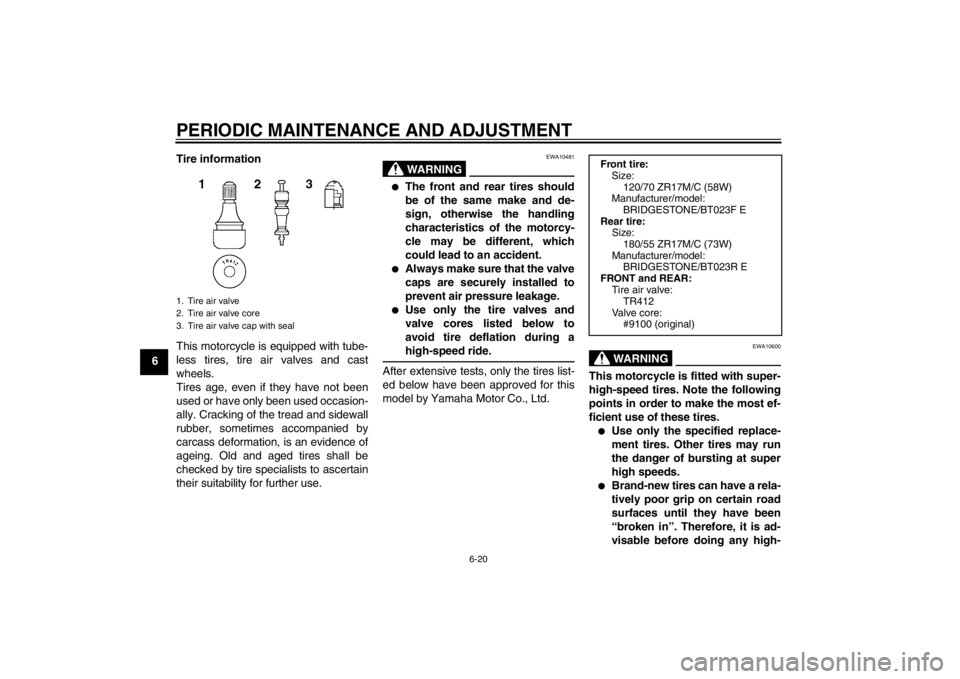
PERIODIC MAINTENANCE AND ADJUSTMENT
6-20
6Tire information
This motorcycle is equipped with tube-
less tires, tire air valves and cast
wheels.
Tires age, even if they have not been
used or have only been used occasion-
ally. Cracking of the tread and sidewall
rubber, sometimes accompanied by
carcass deformation, is an evidence of
ageing. Old and aged tires shall be
checked by tire specialists to ascertain
their suitability for further use.
WARNING
EWA10481
●
The front and rear tires should
be of the same make and de-
sign, otherwise the handling
characteristics of the motorcy-
cle may be different, which
could lead to an accident.
●
Always make sure that the valve
caps are securely installed to
prevent air pressure leakage.
●
Use only the tire valves and
valve cores listed below to
avoid tire deflation during a
high-speed ride.
After extensive tests, only the tires list-
ed below have been approved for this
model by Yamaha Motor Co., Ltd.
WARNING
EWA10600
This motorcycle is fitted with super-
high-speed tires. Note the following
points in order to make the most ef-
ficient use of these tires.●
Use only the specified replace-
ment tires. Other tires may run
the danger of bursting at super
high speeds.
●
Brand-new tires can have a rela-
tively poor grip on certain road
surfaces until they have been
“broken in”. Therefore, it is ad-
visable before doing any high-
1. Tire air valve
2. Tire air valve core
3. Tire air valve cap with seal
Front tire:
Size:
120/70 ZR17M/C (58W)
Manufacturer/model:
BRIDGESTONE/BT023F E
Rear tire: Size:
180/55 ZR17M/C (73W)
Manufacturer/model: BRIDGESTONE/BT023R E
FRONT and REAR: Tire air valve:TR412
Va l ve c o r e : #9100 (original)
U1MDE0E0.book Page 20 Friday, February 15, 2013 1:26 PM
Page 93 of 122

PERIODIC MAINTENANCE AND ADJUSTMENT
6-21
6
speed riding to ride conserva-
tively for approximately 100 km
(60 mi) after installing a new tire.
●
The tires must be warmed up
before a high-speed run.
●
Always adjust the tire air pres-
sure according to the operating
conditions.
EAU21962
Cast wheels To maximize the performance, durabil-
ity, and safe operation of your vehicle,
note the following points regarding the
specified wheels.●
The wheel rims should be checked
for cracks, bends, warpage or oth-
er damage before each ride. If any
damage is found, have a Yamaha
dealer replace the wheel. Do not
attempt even the smallest repair to
the wheel. A deformed or cracked
wheel must be replaced.
●
The wheel should be balanced
whenever either the tire or wheel
has been changed or replaced. An
unbalanced wheel can result in
poor performance, adverse han-
dling characteristics, and a short-
ened tire life.
EAU40620
YCC-S clutch This model is equipped with a hydraulic
clutch, therefore, it is necessary to
check the YCC-S clutch fluid level and
check the hydraulic system for leakage
before each ride. If the YCC-S clutch
plates wear out, shifting becomes
rough or clutch slippage will occur,
causing poor acceleration. If any of the
above occurs, have a Yamaha dealer
check the YCC-S clutch.
U1MDE0E0.book Page 21 Friday, February 15, 2013 1:26 PM
Page 94 of 122

PERIODIC MAINTENANCE AND ADJUSTMENT
6-22
6
EAU37913
Checking the brake lever free
play There should be no free play at the
brake lever end. If there is free play,
have a Yamaha dealer inspect the
brake system.
WARNING
EWA14211
A soft or spongy feeling in the brake
lever can indicate the presence of air
in the hydraulic system. If there is air
in the hydraulic system, have a
Yamaha dealer bleed the system be- fore operating the vehicle. Air in the
hydraulic system will diminish the braking performance, which may re-
sult in loss of control and an acci-
dent.
EAU22282
Brake light switches The brake light, which is activated by
the brake pedal and brake lever, should
come on just before braking takes ef-
fect. Since the brake light switches are
components of the cruise control sys-
tem, they must be adjusted by a
Yamaha dealer, who has the neces- sary professional knowledge and expe-
rience.
1. No brake lever free play
1
U1MDE0E0.book Page 22 Friday, February 15, 2013 1:26 PM
Page 95 of 122
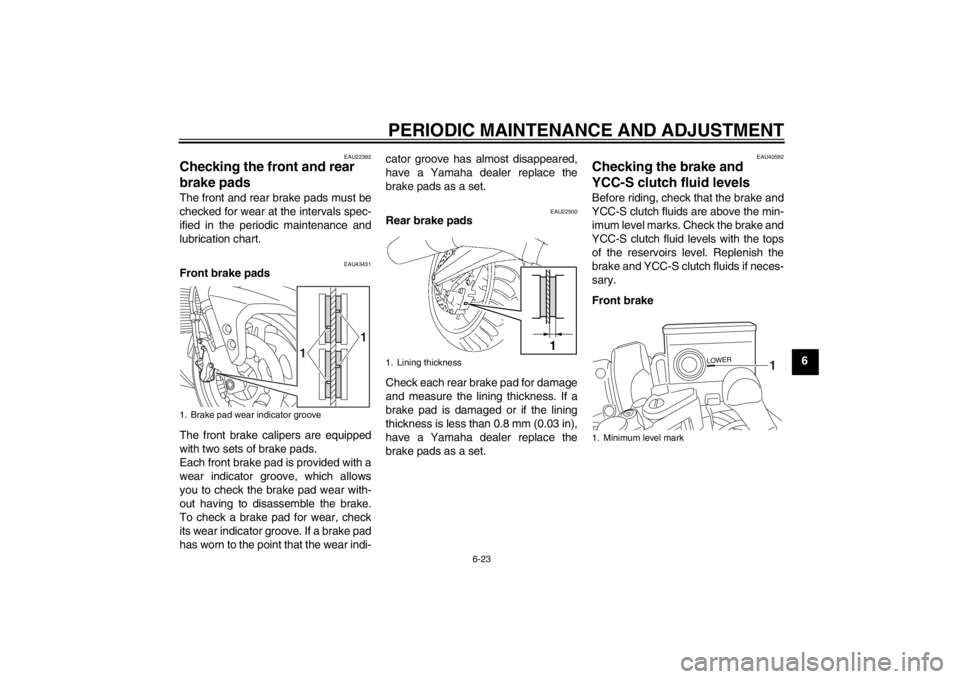
PERIODIC MAINTENANCE AND ADJUSTMENT
6-23
6
EAU22392
Checking the front and rear
brake pads The front and rear brake pads must be
checked for wear at the intervals spec-
ified in the periodic maintenance and
lubrication chart.
EAU43431
Front brake pads
The front brake calipers are equipped
with two sets of brake pads.
Each front brake pad is provided with a
wear indicator groove, which allows
you to check the brake pad wear with-
out having to disassemble the brake.
To check a brake pad for wear, check
its wear indicator groove. If a brake pad
has worn to the point that the wear indi-cator groove has almost disappeared,
have a Yamaha dealer replace the
brake pads as a set.
EAU22500
Rear brake pads
Check each rear brake pad for damage
and measure the lining thickness. If a
brake pad is damaged or if the lining
thickness is less than 0.8 mm (0.03 in),
have a Yamaha dealer replace the
brake pads as a set.
EAU40592
Checking the brake and
YCC-S clutch fluid levels Before riding, check that the brake and
YCC-S clutch fluids are above the min-
imum level marks. Check the brake and
YCC-S clutch fluid levels with the tops
of the reservoirs level. Replenish the
brake and YCC-S clutch fluids if neces-
sary.
Front brake
1. Brake pad wear indicator groove
1
1
1. Lining thickness
1
1. Minimum level mark
1
U1MDE0E0.book Page 23 Friday, February 15, 2013 1:26 PM
Page 96 of 122
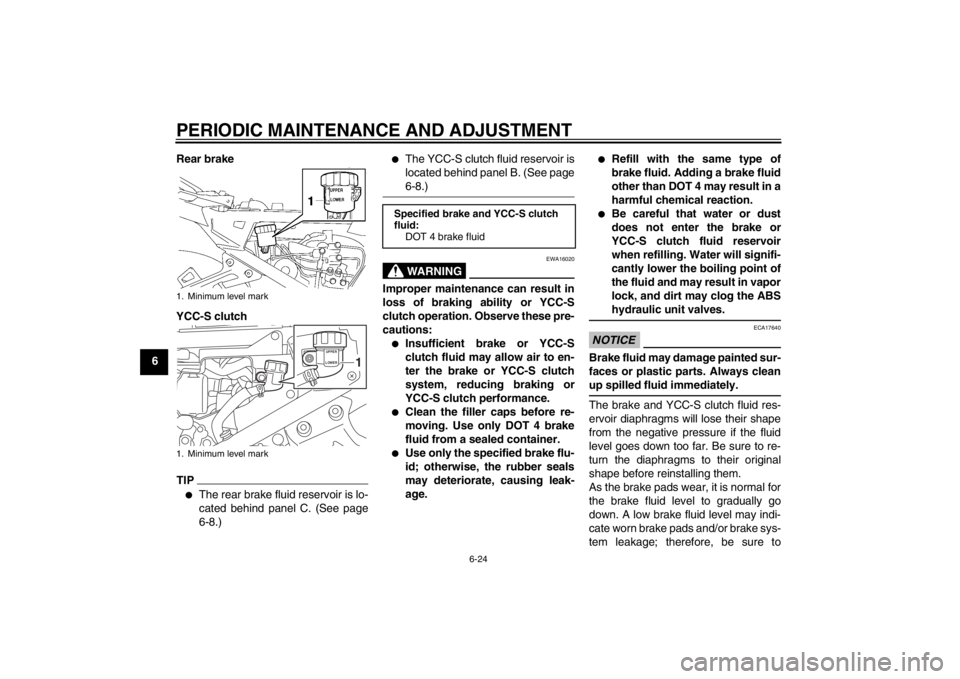
PERIODIC MAINTENANCE AND ADJUSTMENT
6-24
6Rear brake
YCC-S clutch
TIP●
The rear brake fluid reservoir is lo-
cated behind panel C. (See page
6-8.)
●
The YCC-S clutch fluid reservoir is
located behind panel B. (See page
6-8.)WARNING
EWA16020
Improper maintenance can result in
loss of braking ability or YCC-S
clutch operation. Observe these pre-
cautions:●
Insufficient brake or YCC-S
clutch fluid may allow air to en-
ter the brake or YCC-S clutch
system, reducing braking or
YCC-S clutch performance.
●
Clean the filler caps before re-
moving. Use only DOT 4 brake
fluid from a sealed container.
●
Use only the specified brake flu-
id; otherwise, the rubber seals
may deteriorate, causing leak-
age.
●
Refill with the same type of
brake fluid. Adding a brake fluid
other than DOT 4 may result in a
harmful chemical reaction.
●
Be careful that water or dust
does not enter the brake or
YCC-S clutch fluid reservoir
when refilling. Water will signifi-
cantly lower the boiling point of
the fluid and may result in vapor
lock, and dirt may clog the ABS
hydraulic unit valves.
NOTICE
ECA17640
Brake fluid may damage painted sur-
faces or plastic parts. Always clean
up spilled fluid immediately.The brake and YCC-S clutch fluid res-
ervoir diaphragms will lose their shape
from the negative pressure if the fluid
level goes down too far. Be sure to re-
turn the diaphragms to their original
shape before reinstalling them.
As the brake pads wear, it is normal for
the brake fluid level to gradually go
down. A low brake fluid level may indi-
cate worn brake pads and/or brake sys-
tem leakage; therefore, be sure to
1. Minimum level mark
1. Minimum level mark
UPPER
LOWER
1
Specified brake and YCC-S clutch
fluid: DOT 4 brake fluid
U1MDE0E0.book Page 24 Friday, February 15, 2013 1:26 PM
Page 97 of 122

PERIODIC MAINTENANCE AND ADJUSTMENT
6-25
6
check the brake pads for wear and the
brake system for leakage. A low YCC-S
clutch fluid level may indicate YCC-S
clutch system leakage; therefore, be
sure to check the YCC-S clutch system
for leakage. If the brake or YCC-S
clutch fluid level goes down suddenly,
have a Yamaha dealer check the cause
before further riding.
EAU40602
Changing the brake and
YCC-S clutch fluids Have a Yamaha dealer change the
brake and YCC-S clutch fluids at the in-
tervals specified in the periodic mainte-
nance and lubrication chart or in the
TIP after the periodic maintenance and
lubrication chart. In addition, have the
oil seals of the brake and YCC-S clutch
master cylinders and calipers as well as
the brake and YCC-S clutch hoses re-
placed at the intervals listed below or
whenever they are damaged or leak-
ing.●
Oil seals: Replace every two
years.
●
Brake and YCC-S clutch hoses:
Replace every four years.
EAU23095
Checking and lubricating the
cables The operation of all control cables and
the condition of the cables should be
checked before each ride, and the ca-
bles and cable ends should be lubricat-
ed if necessary. If a cable is damaged
or does not move smoothly, have a
Yamaha dealer check or replace it.
WARNING! Damage to the outer
housing of cables may result in in-
ternal rusting and cause interfer-
ence with cable movement. Replace
damaged cables as soon as possi-
ble to prevent unsafe conditions.[EWA10711]
Recommended lubricant:
Yamaha Chain and Cable Lube or
engine oil
U1MDE0E0.book Page 25 Friday, February 15, 2013 1:26 PM
Page 98 of 122
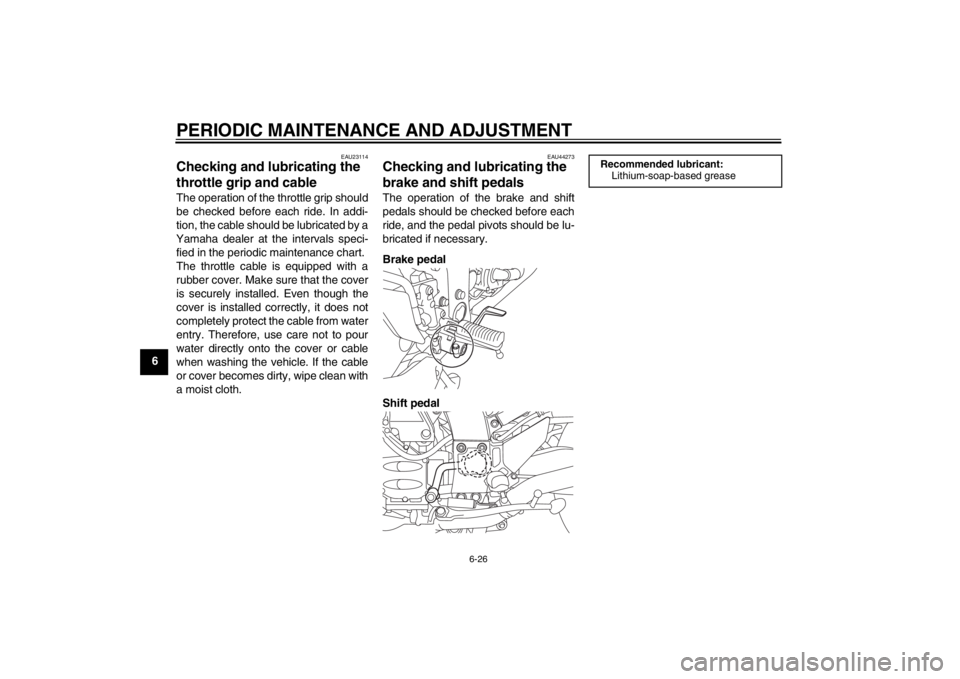
PERIODIC MAINTENANCE AND ADJUSTMENT
6-26
6
EAU23114
Checking and lubricating the
throttle grip and cable The operation of the throttle grip should
be checked before each ride. In addi-
tion, the cable should be lubricated by a
Yamaha dealer at the intervals speci- fied in the periodic maintenance chart.
The throttle cable is equipped with a
rubber cover. Make sure that the cover
is securely installed. Even though the
cover is installed correctly, it does not
completely protect the cable from water
entry. Therefore, use care not to pour
water directly onto the cover or cable
when washing the vehicle. If the cable
or cover becomes dirty, wipe clean with
a moist cloth.
EAU44273
Checking and lubricating the
brake and shift pedals The operation of the brake and shift
pedals should be checked before each
ride, and the pedal pivots should be lu-
bricated if necessary.
Brake pedal
Shift pedal
Recommended lubricant: Lithium-soap-based grease
U1MDE0E0.book Page 26 Friday, February 15, 2013 1:26 PM
Page 99 of 122
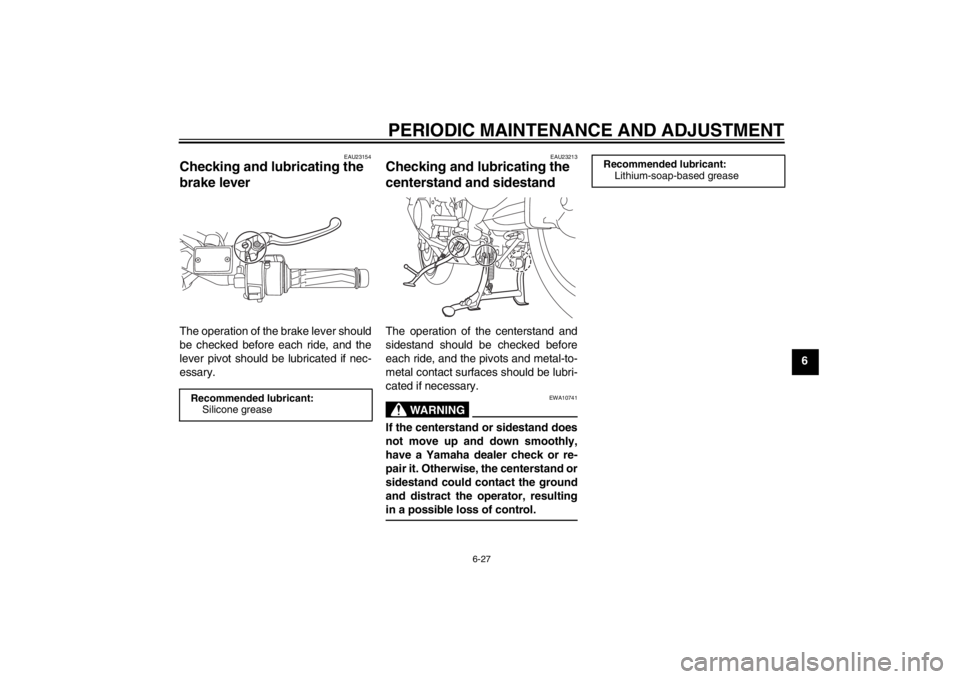
PERIODIC MAINTENANCE AND ADJUSTMENT
6-27
6
EAU23154
Checking and lubricating the
brake lever The operation of the brake lever should
be checked before each ride, and the
lever pivot should be lubricated if nec-
essary.
EAU23213
Checking and lubricating the
centerstand and sidestand The operation of the centerstand and
sidestand should be checked before
each ride, and the pivots and metal-to-
metal contact surfaces should be lubri-
cated if necessary.
WARNING
EWA10741
If the centerstand or sidestand does
not move up and down smoothly,
have a Yamaha dealer check or re-
pair it. Otherwise, the centerstand or
sidestand could contact the ground
and distract the operator, resulting
in a possible loss of control.
Recommended lubricant:Silicone grease
Recommended lubricant:Lithium-soap-based grease
U1MDE0E0.book Page 27 Friday, February 15, 2013 1:26 PM
Page 100 of 122
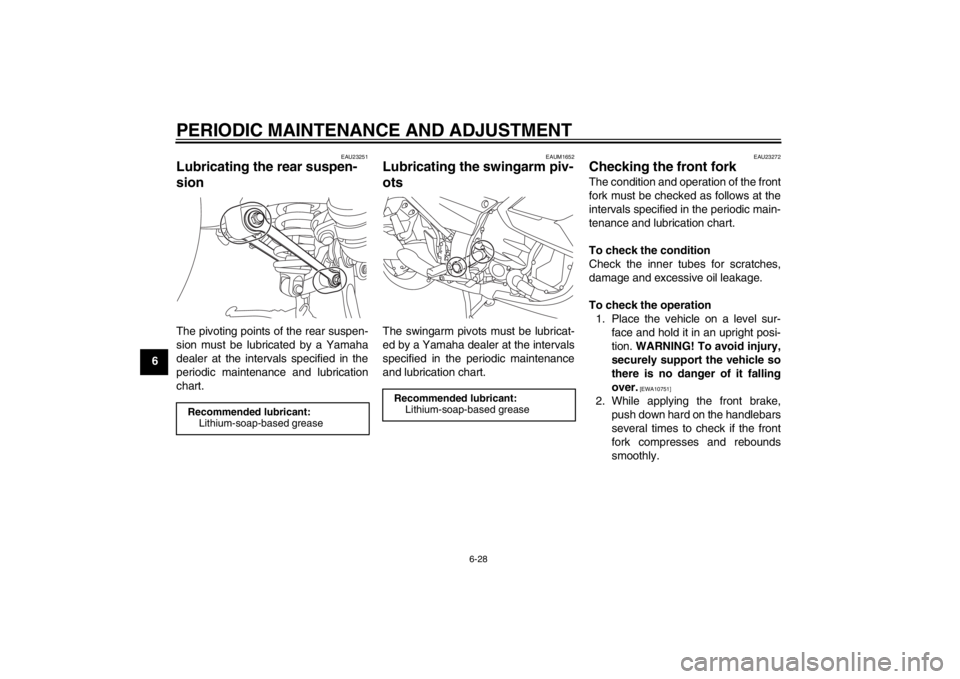
PERIODIC MAINTENANCE AND ADJUSTMENT
6-28
6
EAU23251
Lubricating the rear suspen-
sion The pivoting points of the rear suspen-
sion must be lubricated by a Yamaha
dealer at the intervals specified in the
periodic maintenance and lubrication
chart.
EAUM1652
Lubricating the swingarm piv-
ots The swingarm pivots must be lubricat-
ed by a Yamaha dealer at the intervals
specified in the periodic maintenance
and lubrication chart.
EAU23272
Checking the front fork The condition and operation of the front
fork must be checked as follows at the
intervals specified in the periodic main-
tenance and lubrication chart.
To check the condition
Check the inner tubes for scratches,
damage and excessive oil leakage.
To check the operation1. Place the vehicle on a level sur- face and hold it in an upright posi-
tion. WARNING! To avoid injury,
securely support the vehicle so
there is no danger of it falling
over.
[EWA10751]
2. While applying the front brake, push down hard on the handlebars
several times to check if the front
fork compresses and rebounds
smoothly.
Recommended lubricant:Lithium-soap-based grease
Recommended lubricant:Lithium-soap-based grease
U1MDE0E0.book Page 28 Friday, February 15, 2013 1:26 PM